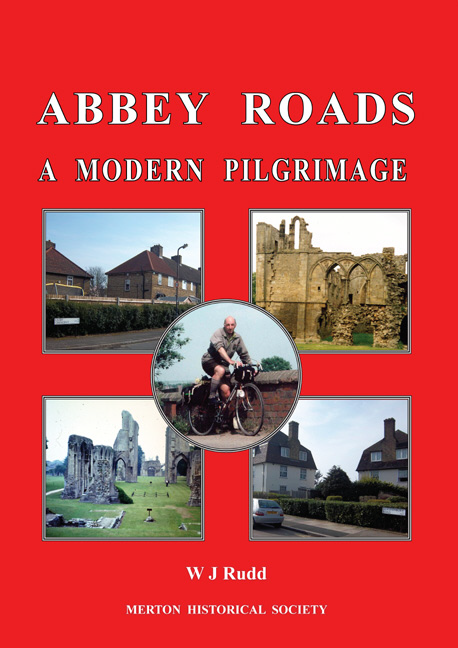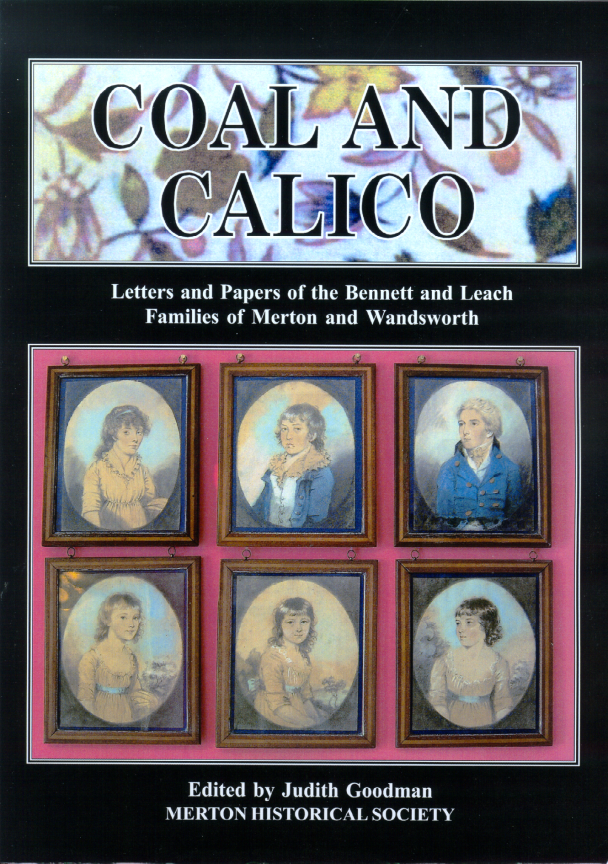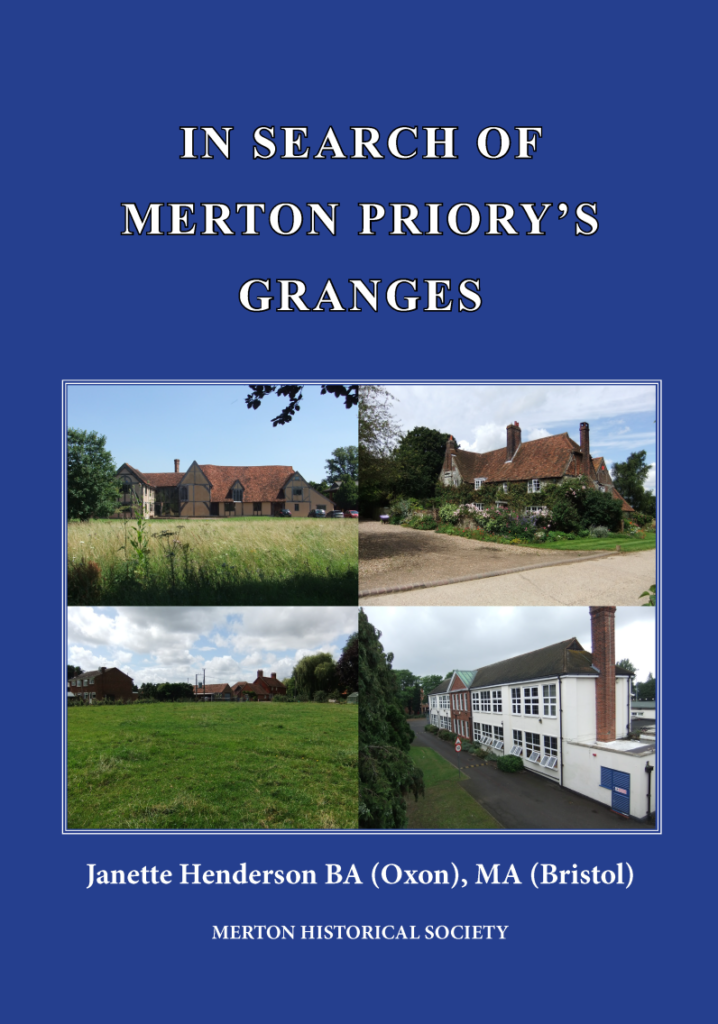Publications
A Thirties Childhood in Mitcham
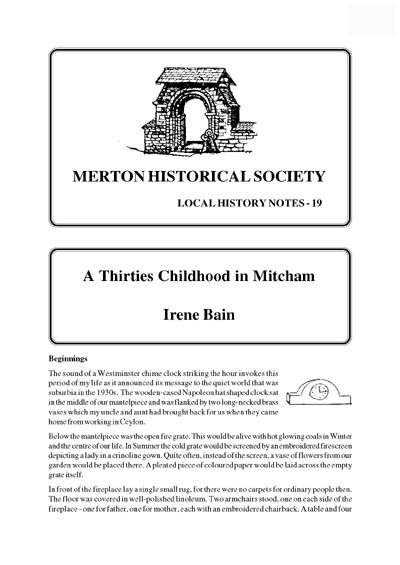
Irene Bain has already enthralled us with her Wartime Memories, published as Local History Notes 7. In this, her second set of reminiscences, she shares her recollections of her childhood – at home, at school, and out and about with family and friends.
A Walk around Merton Rush in the early 20th century

Cyril Maidment has collected photographs and views of all the old buildings that stood on the site of the Nelson Hospital and nearby, identifying the viewpoint of each one. Peter Hopkins has gone through the manorial court rolls to trace the history of each holding from the late 15th century to the 19th. Also included are a Vincent Lines article from a 1929 edition of Wimbledon Boro’ News, information from the 1891 and 1901 Censuses and local directories, as well as several maps.
Abbey Roads: a modern pilgrimage
When it dawned on Bill Rudd that most of the roads in the St Helier Estate in Morden and Carshalton were named after British monastic sites, he conceived the idea of visiting every one of these sites – 108 of them – photographing them and learning what he could about their histories. Abbey Roads, is Bill’s own account of his Project, which he based on his diaries and notes, and this has been illustrated with his fine photographs..
Around Manor Road, Mitcham
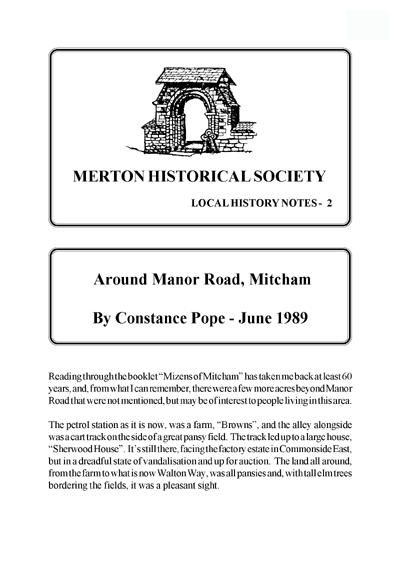
Constance Pope was born at 1 Willow Cottages, Mitcham in 1916, and has lived in the same house ever since. Her recollections of life around Manor Road in the 1920s reflect a way of life long gone, but still fresh in her memory.
Beating the Bounds:
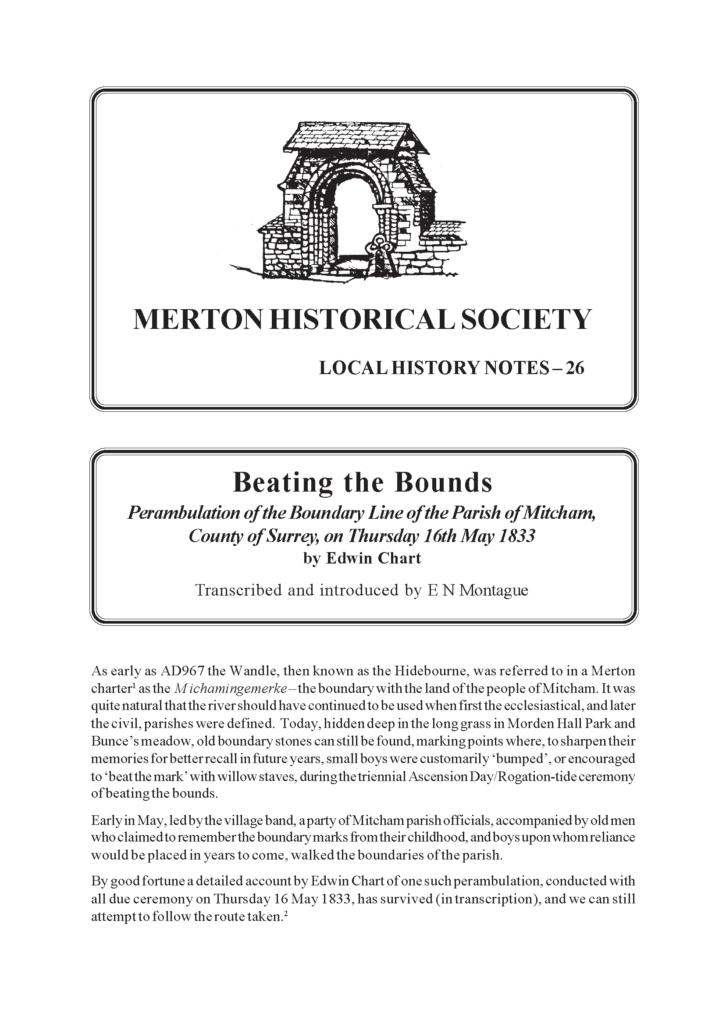
On Thursday 16 May 1833, led by the village band, a party of Mitcham parish officials, accompanied by old men who claimed to remember the boundary marks from their childhood, and boys upon whom reliance would be placed in years to come, walked the boundaries of the parish.
By good fortune a detailed account by Edwin Chart of this perambulation, conducted with all due ceremony, has survived (in transcription), and we can still attempt to follow the route taken.
C & J Greenwood Surrey Described (1823)
To accompany their map of Surrey, the Greenwoods published this Topographical Dictionary of the County. However, they arranged the entries alphabetically by the name of each property, rather than grouping them together by parish.
Coal and Calico: Letters and Papers of the Bennett and Leach Families of Merton and Wandsworth
This publication is concerned with two families who, for several decades in the 18th and 19th centuries, were important in the industrial north-east of the historic county of Surrey. They were the Bennetts, coal merchants of Wandsworth, and the Leaches, calico printers of Merton Abbey. These families, who were at first business contacts and then became friends, were joined permanently when Thomas Bennett married Sarah Jane Leach in 1797. Their grandson, Frederick Bennett, seems to have decided to leave a genealogical legacy to future generations. Firstly, from his own recollections and research he compiled a memoir of the Bennett family; secondly, he assembled the inherited letters and papers into a bound volume, and added his own commentary; and, finally, he put together, from both published and manuscript material, an account of Merton Abbey. Judith Goodman has edited these three projects into this volume.
Copper Milling on the Wandle
Whereas the establishment of copper mills at various locations throughout the Wandle Valley during the late 17th and early 18th centuries occasionally finds a brief mention in the respective parish histories, the phenomenon overall has so far attracted only passing comment and, rather surprisingly, appears not to have stimulated any detailed study by industrial historians.
Daughter Houses of Merton Priory
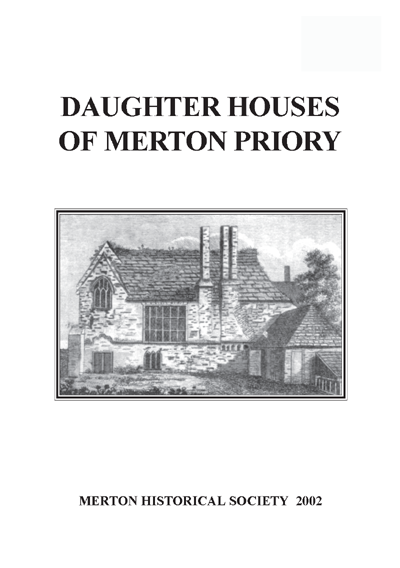
Profusely illustrated with plans, photographs, drawings and tables, the book traces the spread of Merton’s influence in England, Scotland and Normandy, through the setting up Augustinian communities at Taunton, Plympton, Canterbury, Bodmin, Edinburgh, Cirencester, St Lô, Dover and Christchurch within 33 years of the foundation of Merton Priory beside the Wandle.
Digital Classics
Many classic County histories are now accessible in digital format from Google Books or Internet Archive. Although research has moved on over the centuries since they were published, they are still valuable resources. But do remember that not everything in them is accurate. For example, some statements about Morden in fact refer to Steeple Morden in Cambridgeshire, not Morden, Surrey.
Excavation of a Romano-British site at Short Batsworth, Mitcham 1966-68
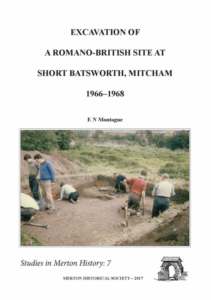
In this study Eric Montague, late Vice-President of MHS, records the history of the site, the dig, the finds and his conclusions. This 32-page A4 booklet has 18 illustrations (maps, plans and photographs) and sells at £2.50 (£2 to members) plus £1.20 postage.
Growing up in Mitcham (1939-1963)
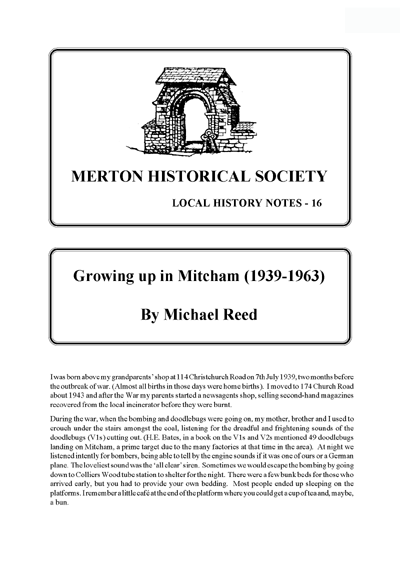
Memories of life in and around Mitcham’s Church Road where the Michael Reed’s parents ran a newspaper shop.
GROWING UP ON THE ST HELIER ESTATE 1930–1950: School, Wartime and First Jobs
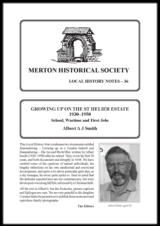 Albert Smith recalls his wartime childhood on the St Helier Estate Morden, his schooldays, and his first job at Hawes Bros, Morden.
Albert Smith recalls his wartime childhood on the St Helier Estate Morden, his schooldays, and his first job at Hawes Bros, Morden.
I Remember… Childhood Memories of Wartime Mitcham
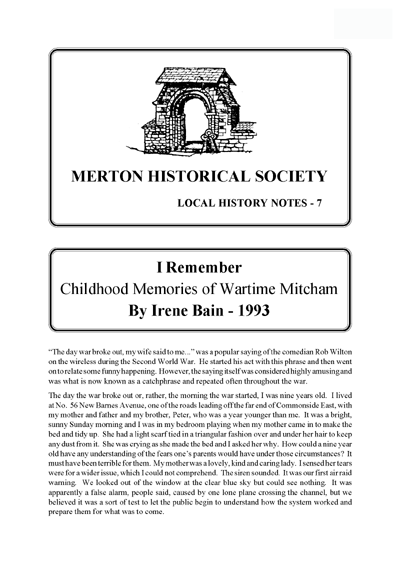
Those who remember the War years will have very vivid memories of all that happened:- of the sudden changes – the house and family across the road that were not there next morning – the ‘culture shock’ of evacuation, etc., etc. Irene Bain has remembered, vividly, life in Mitcham during the War, as it was for a family. For those who weren’t there, this is what it was like.
If you can’t make sterling payments
We have an arrangement with Di And Saul Books for customers who cannot make sterling payments
James Edwards’s Companion from London to Brighthelmston (1789-1801)
James Edwards, a surveyor, set out to measure the distances from London to various destinations along the roads leading to the new seaside resort of Brighton. After publishing a table of distances between two out of a list of 100 villages in East Surrey in 1797, he went on to produce in 1801 a series of maps together with descriptions of the properties to be found along each route.
JUSTICE TO MEN AND COUNTRY: The Mitcham Military Tribunal, 1916–1918
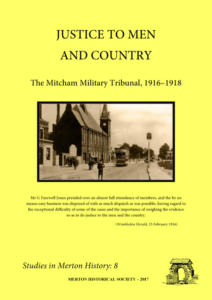 In this study Keith Penny provides information on the ever-changing regulations regarding conscription, and the way these were administered in Mitcham, as reported in the local newspapers of the time.
In this study Keith Penny provides information on the ever-changing regulations regarding conscription, and the way these were administered in Mitcham, as reported in the local newspapers of the time.
Liberty Print Works: Wartime Remembrances
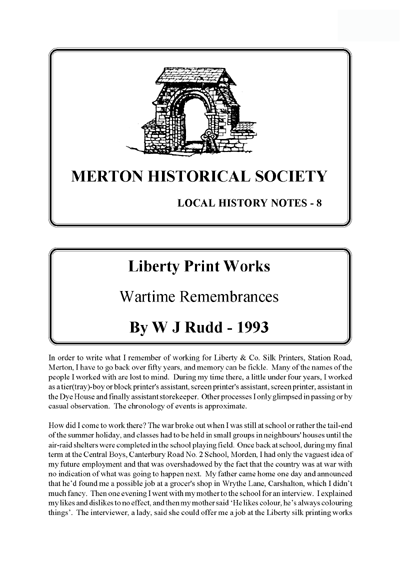
Bill Rudd has achieved a great deal in this paper. There are good clear descriptions of the processes that went on in each of the separate buildings, (together with occasional stories of his personal mishaps), set against a background of wartime life, air-raids, lack of sleep, bomb damage, finding some lunch, etc., ending with call-up in 1943.
This will be of interest to many future historians – the map and illustrations are nice too!
Life at the Cranmers, Mitcham, before the 1914-18 War
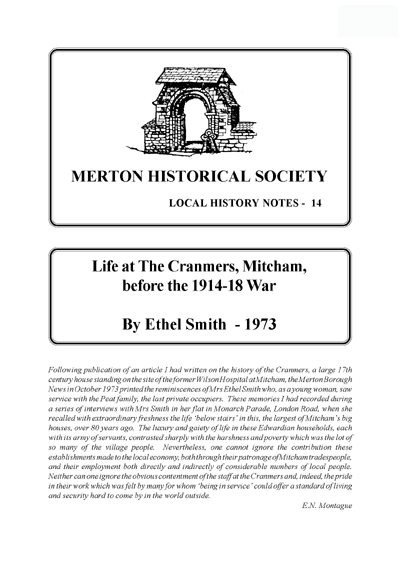
The Cranmers was a large 17th-century house standing on the site of the former Wilson Hospital at Mitcham. Mrs Ethel Smith, as a young woman, saw service with the Peat family, the last private occupiers.
These memories were recorded by E N Montague in 1973 during a series of interviews with Mrs Smith in her flat in Monarch Parade, London Road, when she recalled with extraordinary freshness the life ‘below stairs’ in this, the largest of Mitcham’s big houses, over 60 years before.
 MERTON HISTORICAL SOCIETY
MERTON HISTORICAL SOCIETY 